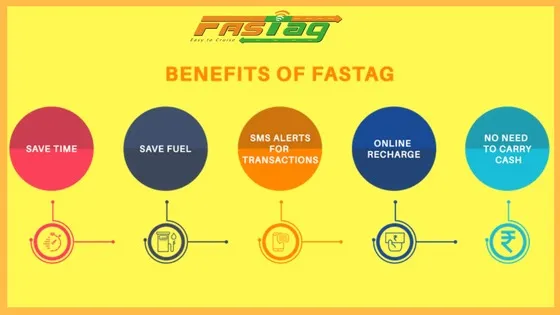What is a FASTag and what all the hype is about
FASTags may seem like a boon for most cases. However, there are several wrinkles in the system that need to be ironed out, especially bringing in state governments to make them work on State Highways.
You must have seen several messages asking you to buy a FASTag or letting you know that you can get one for free. So, what is a FASTag and why do you need it? What does it mean when they say you need a mandatory FASTag from December 1, 2019 and now December 15, 2019?
The Central Government is focussing on Digital India and is now looking to automate India’s highway toll system. This is a big step in getting the country to move from an offline to an online platform.
Apart from rapid digitisation, FASTag will also help in recovering the costs of building world-class roads as it will remove human interference from the system and get rid of leakages which may exist.
FASTag will kill two birds with one bullet – a good experiment to check if India is ready for a digital ecosystem and reduce, if not eliminate, middlemen and corruption from the system, making road building a profitable business for the Central Government.
To ensure that car owners buy a FASTag, the government passed a rule stating that if a car does not have a FASTag, the driver will have to pay double the toll charge as a penalty.

Perhaps the biggest benefit of owning a FASTag is that one will be saved from traffic snarls at every toll plaza. You can also save money with the 2.5 percent discount offered by the government on every toll payment till March 31, 2020.
As of now, the left-most lane at every toll plaza will be open for people who do not have a FASTag. However, the government has made its intentions clear with a 100 percent fine on people who do not follow the rules.
Save fuel, save time
Globally, most developed nations have moved to an electronic toll system for their highways to help them reduce cost and travel time, which also helps in saving fuel. With India planning to build expressways from Mumbai to Delhi, a congestion-free highway will ensure people use the road and removing physical toll stops will go a long way in doing so.
The successful implementation of the FASTag system will also be a good indicator of how Digital India is moving ahead. It will also reveal if there are any problems with the grid once it is connected to a server.
FASTag works on Radio Frequency Identification (RFID) and is affixed to the windshield of your car in a place where it is easily detectable by the sensor at the toll plaza. This sensor will send a signal and deduct the toll amount from your prepaid account or savings account automatically.
A FASTag is valid for five years from the date of activation. All one needs to do is keep recharging the linked account to use it seamlessly.
Seamlessly riding the digital wave
Buying one is also very easy, with various banks and e-wallets selling FASTag. You can also get them for free at any FASTag point-of-sale (PoS) at several NHAI toll plazas and fuel pumps.
To get one at any PoS location, you need to provide your vehicle’s registration certificate, recent passport size photograph, and KYC documents like driving license, PAN Card, passport, Aadhaar card, and voter identification card.

If you buy the FASTag from a PoS location, it is free, and you just have to pay the deposit and minimum recharge amount. If you buy it from a bank or a mobile wallet, you may be charged Rs 100 over the minimum recharge and deposit amount.
The refundable security deposit is Rs 200 while the minimum recharge amount varies between Rs 100 and Rs 200, depending on where you are buying the tag from.
If you are buying a new car, the dealer will procure the FASTag for you.
As a global economy, India cannot miss the digital wave that has taken over the world. Moving forward, we shall be looking at seamlessly connected ecosystems. FASTag is a step in this direction.
The government has also installed electronic surveillance systems, meaning it will be harder to get away with lawbreaking. Now, you will get an e-Challan to electronically pay your fines and ensure your vehicle isn’t impounded.
Limited challenges and tons of potential
Earlier this year, we had the opportunity to test this system while driving from Delhi to Mumbai. We have also been using this system for short drives outside Delhi since April 2018 and interestingly, we only faced a handful of issues.
During the Delhi-Mumbai journey, we ran into some trouble with the system just after Surat. Dust from a whole day of driving had covered the FASTag, rendering it unreadable. A simple windscreen wash solved the issue immediately. Apart from these minor glitches, we saved a lot of time at toll plazas that are usually crowded with a long line of vehicles.
When it was first introduced, only one lane at every toll plaza was a FASTag lane. Entering it required one to convince the personnel manning the lane that your car has a FASTag and is eligible to enter the lane. The National Highway Authority of India sorted this issue by installing FASTag readers at every lane.

But State Highways are a different ball game altogether as most have their own pass system and do not recognise or use FASTags. To ensure people are not inconvenienced, they need to be equipped with appropriate readers.
Has the government bitten more than it can chew?
The Indian government had developed shaky feet before the final launch of the FAStag system. Reports published by leading media houses show that the required infrastructure is lacking at places. This has led to a 15-day delay in implementation.
The question remains, are 15 days enough to solve all these problems plaguing the implementation of FAStag across the country?
India is definitely moving in the right direction with BS-VI vehicles that will emit fewer pollutants. Now, with FASTags, vehicles will save fuel with shorter queues at toll plazas.
For now, we wait to see how well the system works.
(Edited by Saheli Sen Gupta)









